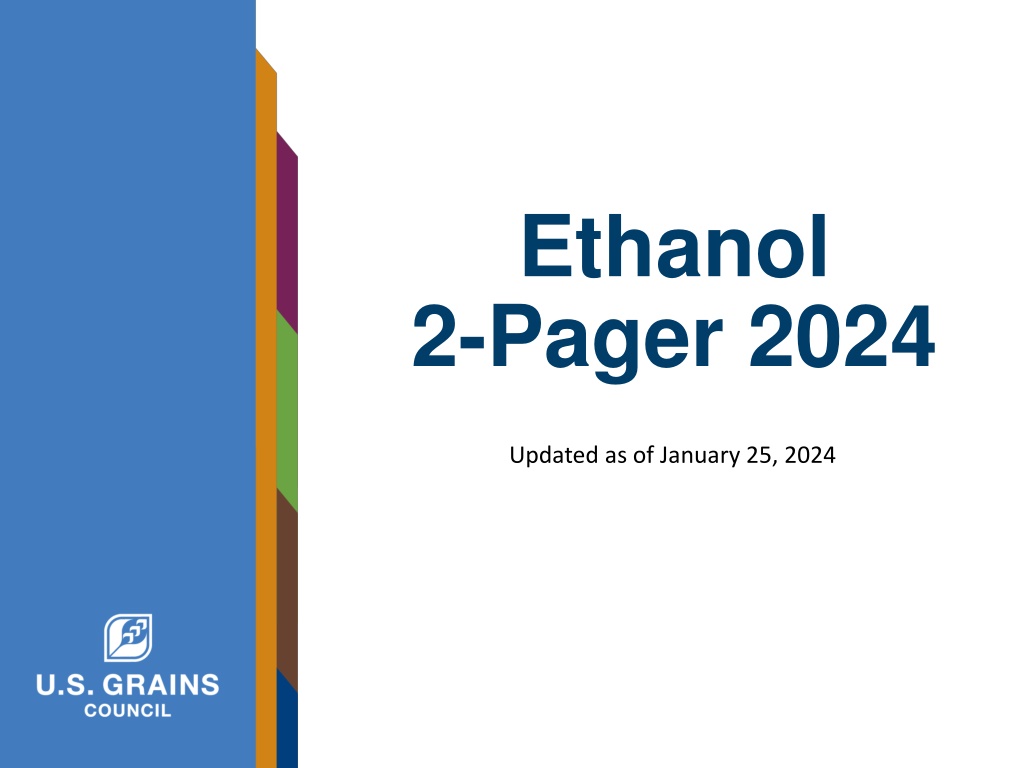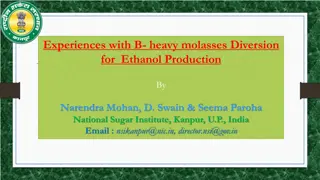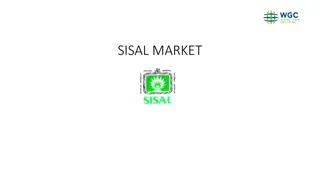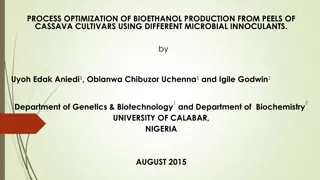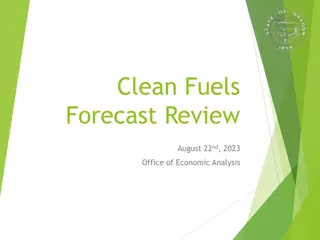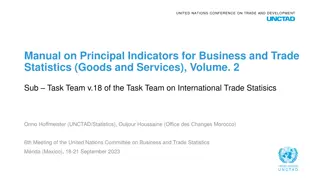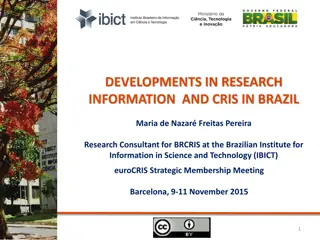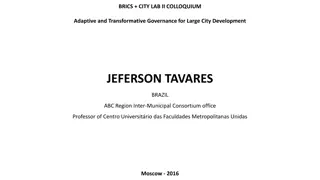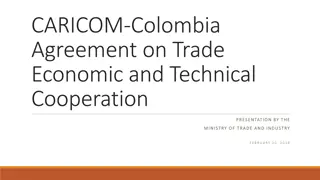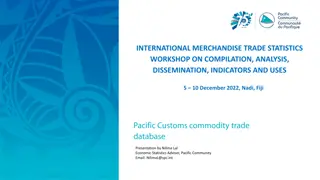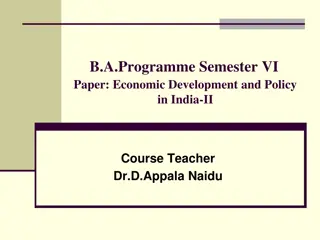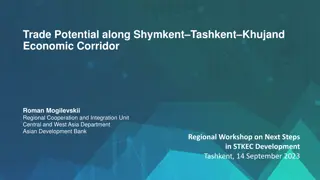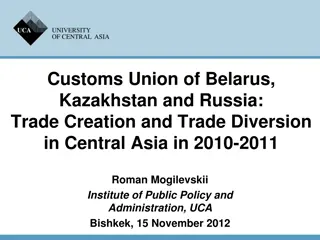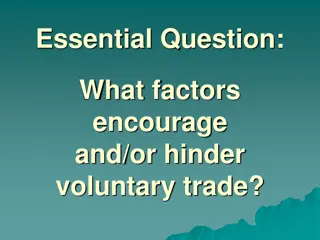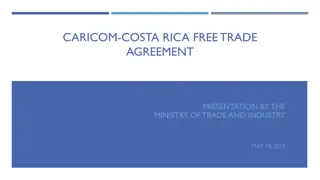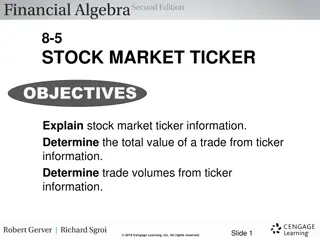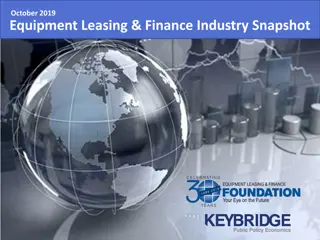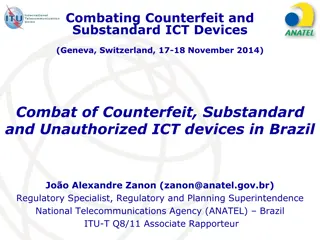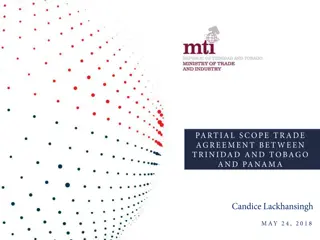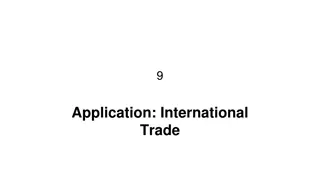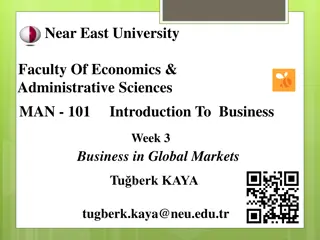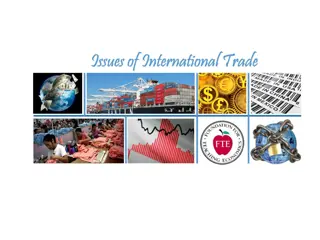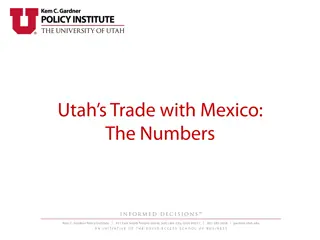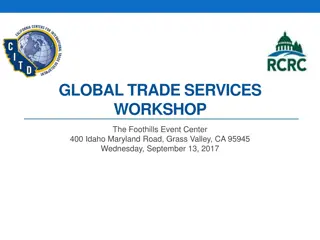Brazil Ethanol Market Snapshot 2024: Trade and Policy Overview
The Brazil ethanol market snapshot for 2024 provides insights into the country's ethanol production, import tariffs, policy overview, supply/demand basics, key market drivers, and the ethanol program snapshot. The report discusses the annual gasoline consumption, growth projections, import/export trends, and the impact of various policies on the ethanol industry.
Download Presentation

Please find below an Image/Link to download the presentation.
The content on the website is provided AS IS for your information and personal use only. It may not be sold, licensed, or shared on other websites without obtaining consent from the author. Download presentation by click this link. If you encounter any issues during the download, it is possible that the publisher has removed the file from their server.
E N D
Presentation Transcript
Ethanol 2-Pager 2024 Updated as of January 25, 2024
Brazil Ethanol Market Snapshot 2024 Trade and Market Share Overview: Country Overview: Annual Gasoline Consumption/ Growth Projection: 11.8 Billion(e); 4% Lula administration announced a potential increase to 30% for the blend mandate. Ethanol production for the CY 2023 in Brazil reached 8.6 billion gallons, of which 5.2 billion gallons were hydrous ethanol and 3.4 billion gallons were anhydrous. During the same period corn ethanol in Brazil reached 1.5 billion gallons production which represents 17% of the total production. Import Tariff: Brazil dropped the duty on March 2022 for all ethanol imports to reduce inflation. However, Lula s administration resume the duty on US ethanol imports, applying a 16% duty until December 31, 2023. For 2024 the government rose the duty to 18% following the Mercosur external duty on all ethanol imports. Policy Overview: Brazil established the RenovaBio program to reduce the carbon intensity of Brazilian fuels. The program has faced inconveniences to reach the targets by fuel distributors and it is under permanent revision. Brazil set the procedures to certify US ethanol plants under the program by the end of 2022. As of now there is a new regulation discussed that would potentially entitle eligibility for most US exporters. Supply/Demand Basics and Key Market Driver: Ethanol trade during the CY 2023 was reduced compared with the previous year based on increased sugar production and the domestic demand. Imports to Brazil were negligible during the CY 2023 driven by high domestic production, and the elimination of the tax exemption on ethanol imports. US ethanol exports to Brazil were only 71,770 gallons during MY 2022/23. Brazilian exports for MY 2022/23 were 717 million gallons mainly to South Korea 247 million gallons, the European Union 188 million gallons and the United States 131 million gallons. Current ethanol market in MY2022/2023 Current ethanol market in MY2022/2023 (fuel and industrial million gallons) (fuel and industrial million gallons) Fuel Use Industrial Use Consumption 7,900 - Production 8,600 - Imports 21 - Exports 717 - Average Blend 27% NA Mandate Blend 27% NA
Brazil Ethanol Program Snapshot 2024 Targeted Goals and Expected Progress Goals Target 2023 Program Results Future Goal Potential Impact After Brazil resume the duty on all ethanol imports the Council partnered with the Association of Fuel Importers to formally request a drop on duties arguing that the duties are beneficial for domestic producers by has affected dramatically the end consumers due to the increased prices at the pump Facilitate market access for all ethanol imports and recover the market share that US ethanol industry had in the Northeast region. Motivate the permanent duty-free access for US ethanol to guarantee the supply in the North and the Northeast region Resume the duty-free treatment that Brazil granted to all U.S. ethanol imports before 2017. Policy After permanent engagements with the National Agency of Petroleum (ANP), Brazil set the rules to certify US product. Besides this ANP is adjusting the current regulation for the certification processes that could potentially secure eligibility for most ethanol plants in the Renovabio certification program. Advocate for the recognition of US regulation that will reduce data requirement for the Renovabio certification Restore continuity of U.S ethanol exports to Brazil and gain full access to the Carbon Credits (Cbios) market. Allow full participation of U.S. ethanol plants in the Renovabio program. Technical
Canada Ethanol Market Snapshot 2024 Trade and Market Share Overview: Country Overview: Tariff rate: N/A 100% U.S. market share Annual Gasoline Consumption/ Growth Projection: 13 billion gallons Canada was the largest year-over-year export market for U.S. ethanol in MY 2022/23, importing 604 million gallons valued at $1.7 billion. Canada s production of fuel ethanol has fulfilled about 67% of the domestic demand for the past 10 years with U.S. ethanol fulfilling the remaining 5% blending requirement under the Clean Fuel Regulation (CFR). Policy Overview: In January 2023, Quebec rolled out its 10% renewable content in gasoline and 15 percent in diesel requirements. In November 2023, Canada approved the U.S. application for legislative recognition, a final hurdle in implementation. In December 2023, British Columbia released its revamped low carbon fuels program, the first jurisdiction in North America to require the use of SAF and targeting an E15 average blend. As of December 2023, 6 provinces have low carbon fuel mandates. In July 2022, final CFR regulations were published with resolved language addressing the previous issues of LUB criteria and CCS credit generation. The U.S. industry continues to work with ECCC to ensure a level playing field with Canadian producers as the CFR comes into force. Supply/Demand Basics and Key Market Driver: Canada is the top export destination import market for U.S. ethanol, importing 604 million gallons valued at $1.7 billion in MY 2022/23. Minimum 5% national blending under the current CFR. The current national average blend rate has exceeded the CFS requirement since 2012, driven by provincial mandates in Quebec, Ontario, British Colombia and Saskatchewan. Current ethanol market in MY2022/2023 Current ethanol market in MY2022/2023 (fuel and industrial million gallons) (fuel and industrial million gallons) Fuel Use Industrial Use Consumption 898 NA Production 475 NA Imports 604 NA Exports 22 NA Average Blend 8% NA Mandate Blend 5% NA
Canada Ethanol Program Snapshot 2024 Targeted Goals and Expected Progress Goals Target 2023 Program Results Future Goal Potential Impact Throughout 2023, the Council engaged with Canadian government officials both the federal level, including members of the Canadian parliament, department officials at Environment and Climate Change Canada (ECCC)/Natural Resources Canada (NRC), domestic biofuels industry groups, and FAS Ottawa to increase ethanol blend mandates at the federal and provincial levels and address and eliminate potential market barriers within the new Clean Fuel Regulation (CFR). The Council will continue to collaborate with close allies Renewable Industries Canada (RICan) and Advanced Biofuels Canada (ABC) as reliable and strong partners in trade and the increased use of biofuels. The Council will also maintain contact with relevant policymakers to address any trade barrier or implementation issues associated with the updated CFR. By extending efforts into the provinces, Canada s average ethanol blend rate will continue to exceed the 5% national mandate. Policy changes at both federal and provincial levels for carbon reduction goals and increased use of renewable fuels present opportunities for increased ethanol use. Higher blend levels and increased U.S. ethanol exports as Canada will continue to rely on imports to meet domestic policy demand. Policy In November 2023, Canada announced that U.S. ethanol was approved for legislative recognition under the CFR LUB criteria and in December 2023 British Columbia released its revamped low carbon fuels program, increasing ethanol blends to 15 percent (E15) and making it the first jurisdiction in North America to require the use of SAF.
Chile Ethanol Market Snapshot 2024 Trade and Market Share Overview: Country Overview: Tariff rate: 6% (MFN tariff rate for industrial and fuel ethanol). Zero duty under the Chile-U.S. FTA. The 3-year average of Chile s industrial ethanol imports has been 12 million sourced mainly from Argentina 46%, and Bolivia 42% Annual Gasoline Consumption/ Growth Projection: 1.2 billion gallons; 2% Expected to service approximately 4 million light-duty vehicles. Chile is the 4th largest fuel market in South America after Brazil, Argentina and Colombia and it is expected that gasoline demand reaches 1.5 billion gallon by 2030 Chile is a major importer of gasoline, 85% is sourced from the U.S. Policy Overview: Supply/Demand Basics and Key Market Driver: There is no ethanol mandate in Chile, the country allows the distribution of E2 and E5. However, no ethanol is blended in the country currently. Chilean authorities are looking to move to EUROVI quality parameters and are currently reviewing fuel specifications to improve air quality, with an emphasis on Volatile Organic Compounds. Decarbonization policies heavily emphasize EVs and local changes to modes of transportation, excluding the potential for ethanol to be utilized as a clean and renewable fuel source. Chile has some of the region s highest fuel quality standard parameters but remains one of only three countries in Latin America still using MTBE. The Chilean government and private sector have refrained from ethanol because of the absence of local production due to limited land availability, which constrains feedstock production. The key drivers for ethanol use are that ethanol is a cost-effective replacement to MTBE, it can help Chile meet its transportation decarbonization goals, and limit fuel emissions to improve air quality. Chile can adopt E10 and E15 can be achieved in 2030 based on the vehicle fleet turnover. 3 Current ethanol market in MY2022/2023 Current ethanol market in MY2022/2023 (fuel and industrial million gallons) (fuel and industrial million gallons) Fuel Use Industrial Use Consumption - - Production - - Imports - 0.3 Exports - 0 Average Blend 0% NA Mandate Blend 5% NA (not enforced)
Chile Ethanol Program Snapshot 2024 Targeted Goals and Expected Progress Goals Target 2023 Program Results Future Goal Potential Impact Assist key government entities (Ministry of Energy and Ministry of Environment) to develop policies recognizing the value of implementing ethanol- gasoline blends. Incorporate ethanol into public policies to demonstrate its emission reduction and decarbonization qualities to open the Chilean market to ethanol use. Incorporate ethanol blending as a part of the Government s measures to decarbonize transportation. After agreeing on a three-way Memorandum of Understanding with the National Refinery (ENAP) and the Ministry of Energy (MEN), the Council focused on developing a study to assess the infrastructure to handle ethanol blending in Chile. The study demonstrated that Chile can effectively blend E10 at the refinery level with reduced investments and minor improvements to the current infrastructure. The MEN and ENAP will continue analyzing the cost of operations and logistics in detail. However, it requires the involvement of the Ministry of Transportation and the Ministry of Environment to assess vehicle compatibility and vehicle emissions under an E10 blending. The outcomes of such analysis will lead to discussions on adopting a blending program in the country. Policy Allow for consideration of U.S. ethanol imports, with an estimated potential of approximately 130 million gallons under an E10 mandate by 2030 Ensure Chile substitutes MTBE use for ethanol and implements a blend mandate. Achieve proscription of MTBE as an oxygenate in gasoline and incorporate ethanol in refining process. Successfully demonstrate that ethanol is a technically superior and more cost- effective option. Demonstrate ethanol s technical benefits over other oxygenates such as MTBE and methanol. Materialize the effective substitution of MTBE for ethanol by ENAP. Technical Dispel any technical concerns associated to the incorporation of ethanol into Chile s fuel logistics infrastructure and provide a cost estimate. Demonstrate logistical feasibility of incorporating ethanol use within existing fuel infrastructure. Gain ENAP s validation of the technical and economic feasibility of incorporating ethanol blending within existing fuels infrastructure.
China Ethanol Market Snapshot 2024 Country Overview: Trade and Market Share Overview: Annual Gasoline Consumption / Growth Projection: 54.3 billion gallons; 3% 2023 GDP growth rate at 5.2%. The 2023 GDP growth rate is projected at 4.6% by the IMF forecast. Low corn stocks and high domestic prices for corn and ethanol resulted in reduced ethanol blending and a stagnant E10 implementation in 2023. High feed (corn) prices make the government and stakeholders very cautious about biofuel promotion in 2023 and the future. Tariff rate: 70% on denatured ethanol (30% - WTO MFN rate, 15% - Section 232, 25% - Section 301, exemptible upon application since March 2020) High tariff rate since 2018 due to US-China trade tension, making U.S. ethanol uncompetitive in price In 2023, both denatured and undenatured ethanol imports were down to a minimal level, but exports did pick up from China to Asia. Policy Overview: Supply/Demand Basics and Key Market Driver: The E10 plan has not been enforced since 2020 due to low corn stocks and rising corn/ethanol prices. The E5 standard was completed in 2021 but will likely not be announced due to industry resistance. In September 2019, China announced its goal to achieve carbon neutrality by 2060. Low carbon attributes for biofuel must be advocated or recognized in future industry planning or policies. Fuel ethanol use in 2023 is estimated at 1.029 billion gallons (or 3.24 million tons), up 7% from the previous year due to a period of profitability early in the year. There will be less blending in certain provinces due to high feedstock prices and limited imports constrained by high tariffs. Ethanol Imports: 200 Thousand gallons (including undenatured). Ethanol Exports: 8.95 million gallons, up 275% from the previous year, were undenatured to neighboring countries for industrial/medical use in 2023 Current ethanol market in MY2022/2023 Current ethanol market in MY2022/2023 (fuel and industrial million gallons) (fuel and industrial million gallons) Fuel Use Industrial Use Consumption 1.029 Billion 2,090 Production 977 1,040 Imports 0.2 0.03 Exports 0.5 8.4 Average Blend 1.8% NA Mandate Blend 10% NA
China Ethanol Program Snapshot 2024 Targeted Goals and Expected Progress Goals Target 2023 Program Results Future Goal Potential Impact Although E10 mandate was not able to be expanded into new provinces/cities due to low corn stocks and unprofitable blending economics, provinces/cities with E10 mandate maintained their blending target. Expand and implement E10 mandate in more provinces/ metropolitan cities; Continue to promote E10 nationwide. Maintain the current 1 billion gallons of fuel ethanol demand and seek potential demand expansion. Reinforce E10 implementation in the provinces of Heilongjiang, Hebei and Jiangsu; Expand E10 in Hubei province. Maintained investment and promotion efforts in social media/state media/industry publications to promote biofuel s benefits in order to reengage the Chinese stakeholders and regain their interest. Develop a favorable public opinion on biofuels. Work with media and industry stakeholders on biofuel policies/standards as China aims to be carbon neutral by 2060. Use lifecycle analysis on domestic ethanol feedstock to reinforce our message on ethanol s environmental benefits. Policy Defend the biofuel policy in China where grain security concerns adversely impacted biofuel development from time to time. Develop and maintain a positive and favorable policy environment for biofuel. Maintained working level engagement on NEA's supervisory work on enforcement of current E10 mandate via social media projects. Develop new partnerships with oil companies, automakers and 3rd country partners to promote liquid fuels severing as a bridge as China moves aggressively towards EV development. Addressing technical issues, challenges from MTBE, methanol, coal- based ethanol sectors Advocated biofuels over other competing oxygenates including methanol, coal-based ethanol and MTBE at several industry conferences and via social media. Gain more support from the oil and auto industry for E10 implementation and expansion. Technical Enhance the understanding of biofuel s role in the decarbonization of the transportation sector.
Colombia Ethanol Market Snapshot 2024 Trade and Market Share Overview: Country Overview: In 2023, the demand for gasoline in Colombia reached +1.7 billion gallons. Regular gasoline (RON 89 - AKI 84) dominates the market, constituting 97%, while Premium gasoline (RON 97 - AKI 94) holds a modest 3% market share. Colombia meets 65% of its national consumption through domestic fuel production and relies on imports, primarily from the United States, to cover the remaining 35%. Despite the countervailing duty (CVD) extension on U.S. ethanol until 2028, there was substantial growth in U.S. ethanol exports to Colombia, surpassing 42 million gallons in MY 2022/2023. This upward trend is expected to persist in the short term, propelling Colombia to the eighth position among the top 10 U.S. ethanol export destinations in MY 2023. Tariff rate: Since 2018 ethanol enters duty free to Colombia under the FTA signed with the U.S. However, in 2020, Colombia applied a $0.066/kg ($0.052/liter) countervailing duties (CVD) on U.S. ethanol imports. In March 2023, the Colombian Government extended the CVD on U.S. ethanol for an additional five years, with a review period set for 2025/26. This decision was taken despite the publication of an Essential Facts Report in January 2023, which recommended a reevaluation of the CVD and explored scenarios including its potential elimination or a 50% reduction. In 2023, U.S. ethanol exports to Colombia grew considerably, and the U.S. Market Share for MY 2020/2023 is 91% of imports. Policy Overview: Supply/Demand Basics and Key Market Driver: Throughout 2023, the Colombian Ministry of Mines and Energy consistently adjusted the monthly ethanol blend rate in response to the local industry's inability to meet the demand for E10. The rate varied between 3% and 7%, with expectations for a transition to E10 by February 2024. The ethanol trade in Colombia faces challenges from measures against U.S. imports, such as the countervailing duty (CVD), possible regulations limiting greenhouse gas (GHG) emissions in ethanol, and stringent quality standards. Colombia remains committed to a "fair energy transition" process, aiming to decrease and eventually eliminate fossil fuels . Biofuels, especially ethanol, emerge as an option to contribute to the decarbonization of the transportation sector. In 2023, Colombian local industry continued to face challenges in meeting the domestic ethanol demand, with Colombia's six sugar mills producing 320 million liters annually. This marked a 9% reduction compared to the output in 2022. Despite the countervailing duty (CVD) extension, Colombia once again emerged as a prominent global destination for U.S. ethanol, ranking 8th, with over 42 million gallons in MY2022/23. This upward trajectory in ethanol imports during the latter part of the year was primarily influenced by a favorable Colombian Peso to U.S. dollar exchange rate, the mandatory blending increase to E7, and the decline in local production. Current ethanol market in MY2022/2023 Current ethanol market in MY2022/2023 (fuel and industrial million gallons) (fuel and industrial million gallons) Fuel Use Industrial Use Consumption 131.5 - Production 85 - Imports 46.5 - Exports 0 - Average Blend 6% NA Mandate Blend 2-7% NA
Colombia Ethanol Program Snapshot 2024 Targeted Goals and Expected Progress Goals Target 2023 Program Results Future Goal Potential Impact Collaborating with the Ministry of Mines and Energy and other key stakeholders to emphasize the significance of preserving E10 ethanol- gasoline blend rate and exploring the necessary actions for a potential increase to E14. Increase U.S. ethanol competitiveness and increase U.S. ethanol exports to Colombia. Maintain market share above 80%. Colombia is assessing the relevance of eliminating the price-setting mechanism for imported ethanol, contending that while it may lower prices for consumers at the pump, it could have implications for imports and profit margins for distributors. Maintain and increase ethanol blend rate and eliminate the price setting mechanism for imported ethanol Reach and maintain E10 nationwide blend rate and eliminate the price-setting measure. In 2023, Colombia continued eliminating the gasoline subsidy, incrementally raising the consumer price of gasoline by approximately US$1.4 per gallon over the year. Policy Compile all legal and technical arguments within the Countervailing Duty (CVD) investigation process and establish strategic alliances with our business partners to safeguard the duty-free access of U.S. ethanol. Reduce any attempts to open a CVD investigation with other trade partners and bring back duty-free access for US ethanol. Eliminate the CVD measures under the new investigation. Eliminate CVD measures on U.S. ethanol imports.
Costa Rica Ethanol Market Snapshot 2024 Country Overview: Trade and Market Share Overview: Tariff rate: 10% MFN duty on imported industrial ethanol, 14% tariff on fuel ethanol. Under the U.S- CAFTA-DR FTA, U.S. industrial and fuel ethanol are tariff free. U.S. ethanol exports to Costa Rica have been negligible over the last years (~$460K in 2023), made up mostly of industrial ethanol. Costa Rica, the second-largest fuel market in Central America after Guatemala, anticipates an annual gasoline consumption of 331 million gallons, with a growth projection of 9% compared to 2022. The country services around 1.6 million vehicles, with an average vehicle fleet age of 11. Motorcycles hold a significant 19.6% market share. Currently, Costa Rica imports its gasoline, mainly from the U.S. and most recently from Kazhajastan. The gasoline market is divided into 95 RON premium (53%) and 91 RON regular (47%), making it unique in the region as it markets more premium gasoline than regular. Policy Overview: The administration of President Chaves is committed to launching a blending program with the primary goal of reducing emissions in the transport sector, while energy security and rural development serve as secondary motivations. Despite Costa Rica's positive reputation for its renewable energy matrix, the country has struggled to make significant progress in decarbonizing the transportation sector. The 2019 ethanol blending program faced obstacles due to consumer resistance and opposition from strategic sectors like vehicle and fuel distributors. Supply/Demand Basics and Key Market Driver: Costa Rica has faced challenges in implementing ethanol-gasoline blending programs in 2005, 2016, and 2019 due to issues like a lack of inter-institutional coordination and opposition from fuel distributors and consumers. Although a national regulation for voluntary blending was established in 2016, it has not been put into effect. President Chaves's administration plans to launch a 10% ethanol-blending program in December 2024, aiming to address emissions concerns. The country exports modest amounts of industrial ethanol, primarily derived from vinasses, mainly to Europe. Current ethanol market in MY2022/2023 Current ethanol market in MY2022/2023 (fuel and industrial million gallons) (fuel and industrial million gallons) Fuel Use Industrial Use Consumption 0 NA Production 0 NA Imports 0 0.2 Exports 0 3 Average Blend 0% NA Mandate Blend 0% NA
Costa Rica Ethanol Program Snapshot 2024 Targeted Goals and Expected Progress Goals Target 2023 Program Results Future Goal Potential Impact Support the implementation of an ethanol blend policy with the Ministry of Environment and Energy (MINAE) and the National Oil Refinery (RECOPE). Continue engagements with current administration (in office until 2025) and rebuild the foundations for a blend policy, leveraging Costa Rica s alignment with international environmental goals. Gain support from the current administration and enable a market of approximately 34 million gallons under an E10 mandate. Initiating Costa Rica's ethanol-gasoline blending program involves collaboration with various government entities. A technical working group comprising the USGC, IICA, MINAE, and ARESEP has been established to facilitate the program's start-up. Policy Demonstrate the benefits of blend levels beyond 8% and establish the mandate at 10% or higher. Continue supporting the transformation of RECOPE towards the production and distribution of renewable fuels. Create mainstream sustainable fuels, including ethanol, within the country. Additionally, efforts included USGC s active participation in public events related to energy transition, aiming to dispel misconceptions about the negative impacts of ethanol on vehicles and the environment. Provide ample technical documentation and assistance to enhance the Government's capacity, aiming to assure the Costa Rican public about the safety of blending ethanol with gasoline. Continued efforts involve ongoing engagement with and training technical staff and policymakers, emphasizing the advantages of ethanol blending to communicate its value to the public effectively. Ensure that government officials and key stakeholders are well- equipped to advocate for the implementation of an ethanol blend policy. Technical Support the National Oil Refinery (RECOPE) in studying the social and environmental benefits of ethanol blending and calculating the long-term economic impact of ethanol use. Ensure that the government and the public identify the alignment of ethanol use with public policy goals. There is a focus on producing technical and academic content that offers support for implementing a blending policy. Executed programs to help RECOPE explore a re-structuring to pivot towards the production of renewable fuels.
CTA Triangle: El Salvador, Guatemala, Honduras Ethanol Market Snapshot 2024 Trade and Market Share Overview: Country Overview: In 2023, gasoline consumption in the CTA Triangle grew 4%, reaching 1.2 b/g annually. Guatemala emerged as the largest market, constituting 59%, followed by Honduras at 23% and El Salvador at 18%, collectively servicing around 4.5 million vehicles. The Central American Technical Regulations (RTCA) established gasoline regulations in the region. Under RTCA, the countries adhere to 88 RON regular gasoline and 95 RON premium gasoline, primarily imported from the United States. On average, regular gasoline holds a 61% market share across these three countries, while premium gasoline accounts for 39%. El Salvador and Guatemala both apply an MFN duty of 40% on imported fuel and industrial ethanol. Honduras applies an MFN duty of 15%. U.S. industrial and fuel ethanol are tariff free (0% rate) under the U.S- CAFTA-DR FTA schedule. Ethanol imports from the U.S. are limited for all three CTA Triangle countries, barely surpassing 27,000 gallons in MY 21/22 Policy Overview: In July 2023, Guatemala's Ministry of Energy and Mines (MEM) introduced Governmental Agreement No. 159-2023, detailing the General Regulations of the Fuel Alcohol (Ethanol) Law. This agreement sets conditions for ethanol blending with gasoline (E10 starting in 2024), emphasizing open competition, environmental considerations, and prioritizing Advanced Ethanol with low greenhouse gas emissions. In 2023, Guatemala had presidential elections that temporarily interrupted several public policies, including the development of the ethanol program. In Honduras, Decree 144/07 outlines the legal framework for biofuels but lacks strict enforcement of blending requirements. In October 2023, during the Global Ethanol Summit, the USGC signed an MOU with the Honduras Sugar Producers Association to promote ethanol blending and technical cooperation. El Salvador is actively considering ethanol use as part of its 2020-2050 Energy Policy, although specific regulations are yet to be established. Supply/Demand Basics and Key Market Driver: Guatemala has five sugar cane mills and distilleries that produce 67 M gal/yr of ethanol (leading producers are Ingenios Magdalena, Pantale n, and Palo Gordo). El Salvador's ethanol production capacity is 17 M gal/yr, and Honduras's is 300 T gal/yr. Implementing an E10 blend mandate in the CTA Triangle presents a market demand of approximately 120 million gallons annually. CTA Triangle combined annual local production amounts to 84 million gallons. It is probable domestic producers, currently exporting to Europe and the U.S. may not want to replace these markets in the short-term due to higher prices. The market opportunity for imports, including U.S. ethanol in the CTA Triangle, once the E10 mandate is established, is estimated in 70 M gal/yr, based on the assumption that local production alone may not sufficiently meet domestic demand. Current ethanol market in MY2022/2023 Current ethanol market in MY2022/2023 (fuel and industrial million gallons) (fuel and industrial million gallons) Fuel Use Industrial Use Consumption - NA Production 84 NA Imports - 3 Exports 45 30 Average Blend 0% NA Mandate Blend 0% NA
CTA Triangle: El Salvador Guatemala, Honduras Ethanol Program Snapshot 2024 Targeted Goals and Expected Progress Goals Target 2023 Program Results Future Goal Potential Impact Advocate for policymakers and key stakeholders to recognize the value of ethanol, urging them to support a mandate ensuring its utilization. Implement an ethanol blend mandate in CTA triangle countries which would create an export opportunity of approximately 120 million gallons per year In July 2023, Guatemala's MEM introduced Governmental Agreement No.159-2023, delineating the General Regulations of the Fuel Alcohol (Ethanol) Law. These regulations emphasized promoting free competition, prioritizing environmental considerations, and giving precedence to Advanced Ethanol with lower greenhouse gas emissions. A subsequent presidential election in late 2023 caused delays in various government initiatives, including the ethanol-gasoline blending program. Ensure that CTA countries incorporate ethanol blending with gasoline as a part of their public policies. Policy Ensure that governments and regulators understand the required legal and operational framework to implement ethanol blends and enact corresponding laws and regulations. Acquire skilled and informed policymakers and regulators to ensure the successful implementation and clear communication of ethanol blend mandates. Improve government officials' comprehension of ethanol usage. The Council actively collaborated with CTA governments and local stakeholders to underscore the importance of ethanol blending. In March 2023, the Council organized the "Cultivando Energia" Regional Conference, convening over 70 high-level CTA officials and private sector representatives to discuss ethanol-related benefits and opportunities. Also, in October 2023, the USGC signed an MOU with the Honduras Sugar Producers Association to promote ethanol blending and foster technical cooperation. Standardize regional fuel specifications to enable and facilitate the implementation of national blend mandates/policies. Help formulate RTCA specifications for gasoline blended with ethanol. Ensure that gasoline and ethanol specifications are developed/modified to enable ethanol blending. The Council engaged with the Central American Integration System (SICA) and governments to develop programs aimed at reviewing and updating RTCA gasoline and biofuels specifications. The USGC-supported study on gasoline quality and the benefits of ethanol blending in Latin America facilitated technical discussions with CTA governments, exploring the possibility of initiating ethanol- gasoline blending programs. Develop a comprehensive awareness of the advantages of ethanol blending in relation to fuel quality. Present technical and non- controversial arguments to initiate ethanol use from the perspective of energy policy. Technical Evaluate and quantify the distinct advantages of ethanol blending concerning fuel quality for countries in the CTA Triangle. Ensure that gasoline quality implications of ethanol blending are appropriately understood and communicated.
Dominican Republic Ethanol Market Snapshot 2024 Country Overview: Trade and Market Share Overview: Annual Gasoline Consumption/ Growth Projection: 570 million gallons; 3% National demand is attended by 20% local production and the rest (80%) is imported from United States, Trinidad and Tobago. Regular gasoline (RON 89) represents 38% of the total demand. The national refinery, REFIDOMSA, has max. production capacity of 34,500 barrels per day (b/d). Since 1979, natural heavy crude oils from Mexico and Venezuela began to be processed, and lately the U.S. has been supplying a growing quantity of inputs. Non-oxygenated gasolines are 89 and 95 RON for regular and premium grades, respectively. Octane requirements for oxygenated gasolines are 90 and 96 RON for regular and premium quality. Tariff rate: 14% MFN duty on imported fuel and industrial ethanol. U.S. industrial and fuel ethanol are tariff free (0% rate) under the U.S- CAFTA- DR FTA schedule. Policy Overview: There are currently no initiatives to establish a program to produce or blend biofuels, but legal and regulatory groundwork has existed since 2007. Decree 65 of 2023, Art 75 entitles to the Ministry of Commerce the responsibility to develop the regulation to commercialize fuel ethanol, oxygenated gasolines and biodiesel. Technical specifications for ethanol and ethanol-blended fuels are stipulated in NORDOM 653. The Council is working with the Ministry of Commerce to assess the benefits of ethanol blending and the implementation of a blend mandate. Supply/Demand Basics and Key Market Driver: There has not been a push to develop a fuel ethanol production capacity or market. There are 3 key market drivers for ethanol use in the DR: It is a cost-effective mechanism to achieve environmental goals It can help the national oil company improve its refining margins It can allow gasoline distributors to leverage existing framework to commercialize gasoline oxygenated with ethanol. Current ethanol market in MY2022/2023 Current ethanol market in MY2022/2023 (fuel and industrial million gallons) (fuel and industrial million gallons) Fuel Use Industrial Use Consumption - NA Production - - Imports - NA Exports - NA Average Blend 0% NA Mandate Blend 0% NA
Dominican Republic Ethanol Program Snapshot 2024 Targeted Goals and Expected Progress Goals Target 2023 Program Results Future Goal Potential Impact Enable the DR to implement an ethanol blending mandate through government appropriations and policies, enabling a potential import market of around 50 million gallons per year. Ensure that the DR incorporates ethanol blending as part of its environmental policies to improve fuel quality, decarbonize transportation and improve air quality. Create a roadmap to assess and implement ethanol blending in the DR, ideally under a blend mandate. Policy The Council presented the results of study that assess the impact of ethanol in gasoline quality, price and emissions to REFIDOMSA. There has been technical interactions with the team at REFIDOMSA that is expected to evolve to a join assessment. Quantify the specific benefits in refining margin for REFIDOMSA from incorporating ethanol blending. Receive technical validation by REFIDOMSA to incorporate ethanol use in the company s refining operations. Ensure that REFIDOMSA validates the economic benefits of ethanol blending in its refining operations and incorporates its use. Permanent engagements with the Ministry of Commerce has created interest in exploring an MoU to assess the economic benefits of using ethanol as a way to reduce government subsidies on fuels. Technical Ensure that gasoline distributors validate the economic benefits of ethanol blended gasoline to move them in the direction of importing preblended product or to import ethanol and blend locally. Enabling price competitiveness of ethanol compared with imported gasoline and facilitate the access to the DR Eliminate taxes applied to ethanol
Ecuador Ethanol Market Snapshot 2024 Country Overview: Trade and Market Share Overview: Tariff rate: approx. 0.84% MFN duty on imported industrial ethanol, 15% on fuel ethanol (exoneration achieved under 2021 Economic Development and Fiscal Sustainability Organic Law) Ecuador s ethanol exports consist mostly of industrial ethanol sold to Colombia and Per Energy and Agriculture, rather than trade policies, have determined the use of locally-produced ethanol in Ecuador s gasoline blends. Annual Gasoline Consumption/ Growth Projection: 1.2 billion gallons; 2% Service approx. 2.4 million vehicles. Fifth largest fuel market in South America after Brazil, Argentina, Colombia and Chile. Ecuador is an oil-producing country but imports a large share of high-octane gasoline to blend in its refining process. Supply/Demand Basics and Key Market Driver: Policy Overview: Ethanol consumption in Ecuador is associated with the Ecopais gasoline program, which uses exclusively locally-produced ethanol, leading to a maximum blend level of 5% in the southern region of the country. Ecuador launched in 2022 the Ecoplus 89 which contains 8% ethanol. However, the program was ended in 2023 because the product was not promoted, and the demand didn t reach the expected levels. While the Ecopais program sought to achieve a 10% blend level, constraints in local production capacity and lack of logistics infrastructure have kept the blend level below 5%. Under a nationwide 10% ethanol blend level, consumption in Ecuador would be approx. 120 M gal/yr. The key market driver for ethanol imports is the potential to dilute the price per gallon of local ethanol with the more price-competitive U.S. product. Current ethanol market in MY2022/2023 Current ethanol market in MY2022/2023 (fuel and industrial million gallons) (fuel and industrial million gallons) Fuel Use Ethanol consumption is dependent on the existing mandate under the Ecopais program, Ecuador liberalized the price of the premium gasoline and maintains the subsidy for Ecopais and Extra gasoline. Locally-produced ethanol procurement volumes and prices continue to be set by the government through contracts between the national oil company and local sugarcane producers. The policy of exclusively using locally-produced ethanol has been detrimental to the achievement of higher blend levels because its limited capacity of production. Industrial Use Consumption 26 NA Production 28 NA Imports - 0.02 Exports 1.9 1.2 Average Blend 2.3% NA Mandate Blend Up to 10% NA
Ecuador Ethanol Program Snapshot 2024 Targeted Goals and Expected Progress Goals Target 2023 Program Results Future Goal Potential Impact Create a market of opportunity of approx. 100 Mgal/yr under an effective 10% ethanol blend mandate. Work with the Ministry of Energy to implement a national 10% ethanol blend mandate. Increase total ethanol blend level and incorporate imports. Enable the long-term sustainability of the market through establishing the mechanism to articulate local production with imports. Policy Work with the Government of Ecuador and the local ethanol industry to achieve the implementation of ethanol imports. Develop a mechanism for U.S. ethanol to complement local production under higher blend levels. in 2023 the Council helped to establish the ethanol promotion group with the domestic producers, Petroecuador and the Ministry of Energy. As part of the activities discussed in the group the Council suggested to conduct an infrastructure assessment to handle E10 countrywide. Engage with the Ministry of Energy and Ecuador s regulating agencies to present the technical case for blend levels beyond 10%. Modify INEN gasoline specifications to allow for ethanol blending at a 10% level in all gasolines. Increase the market opportunity for U.S. ethanol to supplement local production through higher blend levels. Technical Improve price competitiveness of U.S. ethanol by standardizing Ecuador s ethanol specifications to meet current U.S. standards. Modify ethanol water content specifications to allow for 1% water content to improve competitiveness of U.S. ethanol. Achieve modification of INEN 375 to increase the allowable water content in fuel ethanol.
European UnionEthanol Market Snapshot 2024 Country Overview: Trade and Market Share Overview: Annual Gasoline Consumption/ Growth Projection: 24.4 billion gallons Biofuels continue to be the primary renewable transport energy source in Europe. Increased concern over the debunked food and fuel conflict has caused hesitation among consumers unfamiliar with the product. Low margins in 2023 slowed domestic ethanol production into Q1 of 2024. Import tariff: 0.192/liter (Undenatured ethanol), 0.102/liter (Denatured ethanol). The EU tariffs for ethanol for fuel use differ depending on the ethanol content level: Greater than 80% Ethanol 19.2 Euro per hL; Ethanol at any other strength 10.2 Euro per hL. In addition, the EU has several trade preferences for individual countries, regional blocs, and trade development programs. Policy Overview: Supply/Demand Basics and Key Market Driver: As of December 2023, 17 out of 27 EU member states utilize or mandate E10. In 2023, 4 European countries announced the official movement to E10 as the standard grade. As countries transpose new legislation pertaining to higher biofuel blending rates, ethanol demand is expected to be driven by higher member state mandates. In September 2023, the EU initiated a retrospective surveillance measure on fuel ethanol across all countries exporting to the EU, not a trade barrier at this time. In 2018, the EU updated the Renewable Energy Directive (REDII), setting a 14% target share of renewable fuels for the transport sector by 2030. The EU currently has a cap on crop-based biofuels of 7%, allows for the double counting of other renewable fuels, and ban on the use SAF from corn-ethanol In MY 2022/23, exports to EU-27 reached 119 million gallons, making Europe the second-largest ethanol export market, valued at $321 million. Increased ethanol consumption in the EU is attributed to policies driving the increased adoption of E10 across member states. EU currently has 55 first-generation ethanol plants in operation with a combined nameplate capacity of 2.1 billion gallons. The EU is one of the largest markets for U.S. ethanol and the longer-term goal is for the European government to allow full access to corn-based ethanol in its policy revisions based on its science-based carbon reduction benefits. Current ethanol market in MY2022/2023 Current ethanol market in MY2022/2023 (fuel and industrial million gallons) (fuel and industrial million gallons) Fuel Use Industrial Use Consumption 1.7 316 Production 1.5 589 Exports 166 N/A Imports 368 174 Average Blend 7% N/A Mandate Blend Up to 10% as per the Fuel Quality Directive (FQD) N/A
European UnionEthanol Market Snapshot 2024 Targeted Goals and Expected Progress Goals Target 2023 Program Results Future Goal Potential Impact Organized ethanol trade missions to Europe engaging with buyers and importers and further developing relationships with the industry stakeholders in the EU. Achieve E10 blending across all member states. Reach 150-200 million gallons of U.S. ethanol exports into the EU. Continue to grow current exports to the EU. Eliminate existing ethanol tariffs and other trade preferences. Sponsored an independent bioethanol event at International Transport Forum s 2023 Summit in Leipzig, Germany Enhanced ties with IEA by joining its Technology Collaboration Program s (TCP) Task 39 on biofuels for transport. Policy Multilaterals introduce first-generation corn- based ethanol as a solution that brings immediate GHG reduction benefits in the EU and globally. Advocate among multilateral entities for increasing the use of low- carbon fuels such as ethanol to help decrease GHG emissions from the global transportation sector Continued working with additional multilateral organizations (OECD, GBEP, FAO, UNFCCC, World Bank) to show that ethanol is a sustainable and immediate solution to reduce GHG emissions and particulate matter in the EU and globally. Create and grow partnerships with multilateral entities that become broader champions of ethanol in the EU and globally. Identify new multilateral and NGO entities relevant to ethanol messaging and use. Continued to develop relationships with multilateral organizations through our on-ground consultancy firm.
India Ethanol Market Snapshot 2024 Country Overview: Trade and Market Share Overview: Annual Gasoline Consumption/ Growth Projection:13.08 billion gallons; 2.5% Vehicle sales continue to grow as people limit the use of public transport. EVs are the focus, and in 2023, 1.5 million EVs were registered, a 49% increase over 2022. EV penetration is about 6%. Global Biofuels Alliance (GBA) was announced in Sept 2023 under the G20 and encompasses 12 countries. India, the US, and Brazil have pivotal roles. India is taking the lead to enhance biofuel use in other member countries and looking at green financing. By Jan 2024, 9,000 stations are selling E20 blended fuel, but there is no price differential between E10/E20 blend. Supply/Demand Basics and Key Market Driver: Import tariff: 5%, which is equivalent to the Goods and Services Tax (GST) levied on domestic fuel ethanol. It does not harm U.S. ethanol imports. 84% of industrial ethanol imported into India is of U.S. origin. India is the fourth largest market for U.S. ethanol for industrial use. 2023 saw a decrease in market share in favor of Brazil due to higher US ethanol prices and increased domestic supplies. Pressure in the auto industry to shift to flex fuel vehicles and EVs remains. Policy Overview: No fuel-grade ethanol or raw material is allowed to be imported for fuel purposes. Due to higher U.S. ethanol prices, more domestic ethanol was diverted for industrial use. Per the new investment policy, new grain-based ethanol plants or expansions will receive an interest subsidy of 6%. Due to the scheme, the projected investment is $2.5 billion for capacities of 4.5 billion gallons or more. For E20 blends for 2025/26, ethanol demand is projected at 2.68 billion gallons, and the government aims to make grain-based ethanol at least 50% of the mix. For EMY 2022/23, only 1% of ethanol supplies were from corn. For EMY 2023/24, projection is to reach 16% via corn. There is a price incentive for corn based ethanol and assistance in procurement of corn via government agencies. SAF blends are mandated at 1% by 2027 with projections to reach from 20% to 30% in the future. Alcohol to jet will be the primary technology for SAF implementation. Ethanol supplies for fuel used in EMY 2022/23 were projected at 1.72 billion gallons, for a 13% blend, but only 1.29 billion gallons were delivered Ethanol demand for EMY 2023/24 is pegged at 2.38 billion gallons for a 15% blend, First set of supply expectations are for 1.48 billion gallons, of which 0.71 billion gallons are via sugar and 0.77 billion gallons are via grains. This could change as GOI changes its fixed prices for fuel ethanol. India is likely to continue to import ethanol for industrial use and imports could be up to 150 million gallons in 2024. For the EMY 2023/24, there has been an embargo on supply of ethanol from sugarcane juice and b-heavy molasses (BHM) due to a short cane crop. The price of ethanol from BHM was increased to $2.5/gallon. GOI allowed only 1.7 MMT of sugar for ethanol production, yielding 0.29 billion gallons of ethanol. To give impetus to corn for ethanol, the price of ethanol from corn has been increased to $3.23/gallon. Current Current ethanol market in MY2022/2023 ethanol market in MY2022/2023 (fuel and industrial million gallons) (fuel and industrial million gallons) Fuel Use Industrial Use Consumption 1720 290 Production 1290 239 Imports - 51 Exports - - Average Blend 9.86% NA Mandate Blend 13% NA
India Ethanol Program Snapshot 2024 Targeted Goals and Expected Progress Goals Target 2023 Program Results Future Goal Potential Impact Expand market access for fuel ethanol to reach a target of E15 blend in 2024 across India and E20 blend in 2025. The government and industry have firmly recognized that fuel ethanol imports are needed, and USGC has given USTR information to help negotiate for fuel ethanol imports. Work with Indian industry to promote and achieve E20 via trade. 430 million gallons of fuel ethanol Policy Create Biofuels Taskforce with key partners. Promote ethanol production and pro ethanol messages at all levels across Indian and the U.S. The Council has proven the feasibility of corn ethanol as their domestically sustainable solution to achieve E20. Provide concrete goals and a narrative on the Global Biofuels Alliance. Keep ethanol relevant in India and the U.S. Mapped out all upcoming ethanol capacity in India. Expand ethanol s use across sectors in India. Create a space for ethanol in the climate change conversation outside of fuel blending. Worked with ethanol producers to improve corn DDGS quality and marketability in India, to ensure their profitability going forward. Ensure corn ethanol producers are profitable to shrink India s corn supply, while also understanding that fuel ethanol imports will be necessary to achieve India s E20 goals. 500 million gallons of increased industrial ethanol demand Technical Expand ethanol demand in India via cookstoves and SAF. Mapped out strategies for future ethanol expansion in cookstoves and SAF.
Indonesia Ethanol Market Snapshot 2024 Trade and Market Share Overview: Country Overview: Tariff rate: 30% Ethanol uncompetitive compared to other octanes (MTBE at 5% and Benzene at 0%). Unfair advantage for other octanes results in over-reliance on MTBE and Benzene for Pertamina and other fuel marketers. This tariff is prohibitive for imports and results in minimal tax revenue generation. Pertamina s gasoline import specs allow maximum ethanol content at 3% volume. Gasoline imported to Indonesia mainly originates from Singapore where traders opt for ethanol as a RON enhancer given favorable pricing conditions vs aromatics (e.g., MTBE). Annual Gasoline Consumption/Growth Projection: 10.6 billion gallons; 2.5% Expected to grow to world s sixth largest gasoline market. Domestic gasoline refinery capacity is 4.5 billion gallons per year. Imported gasoline supplies over 50% of total consumption. Indonesia aims to achieve net zero emissions by 2060. The country has set out to achieve 23% and 31% renewable energy use by 2025 and 2050, respectively. Supply/Demand Basics and Key Market Drivers: Feedstock constraints (high price, low supply) makes current domestic ethanol production prohibitively expensive. Domestic production cost is estimated at $3.20 per gallon Indonesia s 2024 National Budget allocates $1.7 billion for fuel subsidies. Gasoline is expected to account for 55-60% of total subsidies. Pertamina in 2024 will increase production capacity at its Balongan and Balikpapan refineries, with an estimated additional 0.9 billion gallons of gasoline production. Main demand grade of RON90 gasoline to be phased out in 2024 and be replaced by RON92. Policy Overview: Ethanol blending of 3.5-5% was introduced in 2007 under Biopertamax in line with MEMR Regulation No.32/2008, which mandated ethanol blending. Ethanol blending halted in 2010 due to high domestic ethanol prices. Updated MEMR Regulation No.12/2015 mandates E5 by 2020 and E20 by 2025, though the mandates are not enforced. Pertamina in 2023 introduced E5 blended gasoline branded as Pertamax Green RON95 in a pilot program of 17 retail stations in Jakarta & Surabaya. Pertamina projects an ethanol demand of 475,000 gallons in 2023 for the pilot. This can be fully supplied by domestic ethanol (10.5m gallons/year). Pertamina has announced plans in 2024 to increase Pertamax Green from E5 to E8 Current ethanol market in MY2022/2023 Current ethanol market in MY2022/2023 (fuel and industrial million gallons) (fuel and industrial million gallons) Fuel Use Industrial Use Consumption 0 42.7 Production 1 56.7 Imports 0 3.1 Exports 0 19.8 Average Blend 0% NA Mandate Blend 5% NA
Indonesia Ethanol Program Snapshot 2024 Targeted Goals and Expected Progress Goals Target 2023 Program Results Future Goal Potential Impact Pertamina engagement evolved from education & awareness on the benefits of ethanol to providing close advisory and support on technical and commercial considerations for ethanol use. USGC s support to Pertamina allowed relatively quick implementation of Pertamax Green E5. USGC is now Pertamina s main point of reference for ethanol resources. Our engagement culminated in the commercial business unit s Director of Strategy attending GES 2023 (this division is charged with implementing and expanding the E5 pilot). Provide technical support on infrastructure requirements/feasibility study for ethanol pilot expansion. Facilitate commercial discussions with U.S. exporters to ensure import readiness. Provide Pertamina necessary technical support to expand E5 pilot in relation to import/storage/retail capacity Government engagement extended beyond EBTKE to MSOE through SGN (state owned sugar company). In the anticipation of the upcoming Sugar Self Sufficiency Regulation which was legislated in 2023, USGC sponsored the Indonesian National Sugar Summit organized by SGN and MSOE in December 2022. USGC was able to expand our relationship with SGN and MSOE both are now engaging USGC to develop the sugar self sufficiency roadmap. A team from SGN also attended GES 2023 where SGN indicated their acceptance of ethanol imports to supplement and stimulate domestic industry growth. Wider engagement to government, especially DG Migas and MOF, to advocate favorable ethanol policies (e.g., establish national product specification for ethanol blended and base gasoline, reduction of 30% tariff). E7 mandate creating a 580 million gallon potential ethanol export market. Government engagement and to leverage on Presidential Regulation on Sugar Self Sufficiency and Bioethanol Provision as Biofuel Policy Provide specialized reports on ethanol developments in SEA countries to drive higher demand and liquidity for ethanol trades in Singapore. Highlighted ethanol opportunities and challenges for gasoline blending with oil companies. Underscored impacts to regional blending and trading should pending/targeted mandates realize or expand. Advocate ethanol blending to oil companies in Singapore supplying Indonesia.
Japan Ethanol Market Snapshot 2024 Trade and Market Share Overview: Country Overview: Import tariff: Undenatured ethanol (HS220710): 5.4% (2022), 4.5% (2023), 0.9% reduction per year to 0% (2028) under USJTA; Denatured ethanol (HS220720): 27.2% Government GHG emission reduction requirement: 55% of gasoline U.S. import market share has no ceiling, price dependent market with Brazil Industrial market demands non-biotech source Negative against Brazil sugarcane ethanol Annual Gasoline Consumption/ Growth Projection: 11.8 billion gallons; -2.5% Third largest gasoline consumption country. Gasoline consumption is declining and is expected to continue to decline due to a reduction in population and an increase in more efficient vehicles. Imports all its crude petroleum. Most gasoline consumed in the country is produced domestically. Supply/Demand Basics and Key Market Driver: Little domestic production. Heavily depends on imports for both fuel and industrial use. Exports from Brazil, Pakistan, and the U.S. have dominated the market. Most industrial ethanol shipped to South Korea by large vessels, is re-shipped to each Japanese customer via small vessels, which generates discrepancy between U.S. and Japanese ethanol trade statistics The government mandates 500,000 million liters of crude oil equivalent to ethanol per year into gasoline, in which ethanol is blended as ETBE. GHG emission reduction target for transport bioethanol at 55%. Over 90% of ETBE is produced and imported from the U.S. and is made from Brazilian and U.S. ethanol. Total imports from the U.S. were 16 million gallons for industrial use (11% market share), and 152 million gallons for fuel use imported as ETBE (70% market share). A small gasoline blender sells E3 gasoline and started to sell E7 gasoline in 2023 Current ethanol market in MY2022/2023 Current ethanol market in MY2022/2023 (fuel and industrial million gallons) (fuel and industrial million gallons) Fuel Use Policy Overview: Declared carbon-neutral by 2050 Positive but no mention of ethanol Current biofuel policy revised in 2023 Removed ceiling of the U.S. market share E3 legally permitted but not known by the consumers E10 specification exists only for E10 compatible vehicles but virtually not sold Is Industrial Use Consumption 239 144 Production 0.05 3 Imports 239* 147 Exports 0 0 Average Blend 1.9%** NA Mandate Blend 1.9% NA *Included imported ethanol as ETBE **National average blend rate
Japan Ethanol Program Snapshot 2024 Targeted Goals and Expected Progress Goals Target 2023 Program Results Future Goal Potential Impact Worked with policymakers, government offices and relevant industries removed the ceiling of U.S. ethanol import market share. Full market access of U.S. fuel ethanol export in the 217 million gallons mandate. Ensure future revisions will continue full market access. Increase import market share by revising LCA in the next biofuel policy. Policy Continued working with policymakers and the relevant industries to promote ethanol direct blending. Develop a higher ethanol direct blending policy through government relations. Introduce higher direct ethanol blend rate up to E10. Generate 1.2 billion gallons of fuel ethanol demand (E10). Oil refineries introduce ethanol in their business Generate 1.2 billion gallons of fuel ethanol demand (E10). Gain support of a higher ethanol blend policy from the industry and the public. Foster the relationships with the government, refineries and auto manufacturers on higher blending. Technical Foster the relationships with the major refineries and the airline companies on use of ethanol for SAF and fine chemicals General ethanol exports for SAF market at 150 million gallons in 2027 and 340 million gallons in 2030. Ensure use of U.S. ethanol for SAF production and fine chemicals Build relationship with key industries on uses of ethanol for sustainable aviation fuel and biorefineries
Malaysia Ethanol Market Snapshot 2024 Trade and Market Share Overview: Country Overview: Oil companies currently do not allow ethanol for gasoline imports citing a government ban. However, the government regulator does not explicitly state allowance/prohibition of ethanol in gasoline specs. Although current volatility in oil prices will likely minimize short-term opportunities, the long-term value of ethanol remains particularly as a tool to arbitrage octane and as a feedstock for sustainable aviation fuel (SAF). Annual Gasoline Consumption/Growth Projection: 4.7 billon gallons; 2.5% Domestic gasoline refining capacity is 4-4.5 billion gallons per year after a new refining & petrochemical integrated facility came fully online in 2022. However, gasoline imports still account for 20-30% of supply due to refining strategy and arbitrage opportunities. Malaysia targets carbon neutrality by 2050. It aims to reduce the carbon intensity of GDP by 45% before 2030 Government policies on EV for low carbon mobility with a target of 15% EV penetration by 2030. EV penetration for 2023 is projected at 1.8% due to lack of extensive infrastructure. Accordingly, tax incentives are geared towards EV ownership, production and infrastructure building. Policy Overview: Ethanol and industrial alcohol have been under threat in recent years from a trend towards Halal products. As a result, undenatured ethanol imports are heavily tariffed at RM228 (USD 50.60) per gallon. Denatured ethanol imports face slightly lower tariffs of RM 8.40 (USD 1.85) per gallon plus 15%, but the duty is still prohibitive. Petronas is tasked to develop Malaysia s future SAF supply beyond UCO feedstock. To that end, Petronas plans to conduct feasibility studies on using palm, ethanol, pangomia and jatropha as SAF feedstocks. The government also established an SAF taskforce which is headed by the Civil Aviation Authority of Malaysia (CAAM). Regulators aim to establish a 1% SAF mandate in the 2020s, eventually scaling to a 47% mandate by 2050. Supply/Demand Basics and Key Market Drivers: RON 95 gasoline is subsidized with a price ceiling re-introduced in 2018. Other grades available are RON97, RON98 and RON100. The government announced plans to phase off a blanket subsidy of RON95 in 2H 2024. Malaysia produces its own octane, mainly MTBE, for gasoline blending. The production capacity is set to increase as PETRONAS new refinery, RAPID, begins to stabilize production. Current ethanol market in MY2022/2023 Current ethanol market in MY2022/2023 (fuel and industrial million gallons) (fuel and industrial million gallons) Fuel Use Industrial Use Consumption - 3 Production - - Imports - 3 Exports - 0.03 Average Blend 0% NA Mandate Blend 0% NA
Malaysia Ethanol Program Snapshot 2024 Targeted Goals and Expected Progress Goals Target 2023 Program Results Future Goal Potential Impact Engaged Petronas corporate strategy team to underscore arbitrage opportunities for octane, aiming to mitigate their pro-MTBE bias for gasoline RON enhancement. During GES, the team was closely engaged in the wide usage and benefits of ethanol blends. The team is agreeable to move forward with conducting a feasibility study on ethanol vs MTBE, subject to their senior management s approval. In addition to gasoline blending, Petronas is also studying the feasibility of ATJ for their SAF production plans. RAPID refinery will produce SAF in 2025 using UCO but more production will be required to meet Malaysia s SAF demand. Advocate for Petronas to engage TMC to conduct comprehensive feasibility study (including capex investment, economics of displacing MTBE) for ethanol blending into gasoline. NDA will be required to facilitate thorough input from Petronas to maximize the efficacy of the study. Remove all tariff and non- tariff barriers on fuel and industrial ethanol imports; convince Petronas to adopt ethanol blends 215 million gallons potential ethanol export market, given a discretionary E5 policy. Policy Pilot plant producing ethanol from palm kernel cake (PKC) is expected to commence in 2024. However, the pilot has been moved to Lampung in Java, Indonesia. Investors are still evaluating PKC ethanol, but feasibility studies are still in early stages. Key stakeholders including Petronas signaled strong interest in augmenting any domestic PKC ethanol production with U.S. ethanol. Continue engaging PKC-to- ethanol contacts with possible collaborations to engage the palm oil industry / government agencies. If PKC-ethanol is viable, this would be a strong business case for Petronas to adopt ethanol where imports will be required to supplement domestic production. Generate potential for ethanol as a blendstock for Malaysian SAF
Mexico Ethanol Market Snapshot 2024 Country Overview: Annual Gasoline Consumption/ Growth Projection: 800-850 MBOPD After an 8.5% drop in the GDP at the end of 2020, the economy has rebounded, and it is estimated that the current administration will close its six-year term with positive numbers. Nearshoring, public and private investment, and a strict management of the macroeconomy have been some of the positive factors Trade and Market Share Overview: 600 million to 1 billion gallons is the potential market depending on the regulation and ethanol penetration scenarios Domestic production is key for the federal government to promote biofuels and initiate an open ethanol market Ethanol can provide the additional volume needed to achieve energy self- sufficiency and begin the decarbonization of the transportation sector The new refinery in 2 Bocas, Tabasco, the Mayan train, and the trans- seismic corrido are large projects that represent opportunities for the inclusion of ethanol in Mexico Supply/Demand Basics and Key Market Driver: Throughout 2023, Mexico has de facto continued reversing the energy reform carried out by the last administration despite the legal framework. "Strengthen Pemex again" has been the policy of AMLO s administration, which means energy self-sufficiency, reduction of gasoline, diesel, and gas importation, increased oil production, and more refining capacity and efficiency. However, Mexico is still far away from a production of 2.5 million barrels per day and a crude oil processing efficiency above 85%. Modernization of the refineries to reduce heavy residuals and increase high-value oil products is still missing, and the new refinery in Tabasco has not started operations. Mexico lacks a fuel ethanol industry. In the last years, illegal blends with gasoline have been used to increase profits from the distribution side. This tendency grew so rapidly that last October the Ministry of Energy published a decree to "establish measures to combat the illicit fuel market" Meanwhile, the sugar cane industry and producers are losing money by selling surplus sugar at a very low price in the international market, instead of producing ethanol and simultaneously developing the rural area of Mexico Policy Overview: New reformulation of gasoline is needed to produce base gasoline (BOB or RBOB) and include E10 to comply with the regulation. Subsidies of gasoline prices by the federal government are slowly decreasing in Mexico, which could encourage companies in the fuel market to import ethanol during a high fuel price season PEMEX will achieve great economic benefits from E10 blending because MTBE is being used countrywide to meet the octane specification SAF-ATJ boost and the slow transition to net zero in the transportation sector represent an opportunity for ethanol in Mexico 2024 will be a challenging year due to the Presidential election. Public officials are more committed to the transition of power process. Current ethanol market in MY2022/2023 Current ethanol market in MY2022/2023 (fuel and industrial million gallons) (fuel and industrial million gallons) Fuel Use Industrial Use Consumption 46.42 6.61 Production 4 0.6 Imports 0 53.04 Exports 0 0 Average Blend NA NA Mandate Blend NA NA
Mexico Ethanol Market Snapshot 2024 Targeted Goals and Expected Progress Goals Target 2023 Program Results Future Goal Potential Impact Since the regulatory authority (CRE) did not convene the working group to modified standard 016, we actively work with the environmental sector to clarify the benefits of ethanol. Continue with the technical advocacy efforts with the environment and energy sectors Modify NOM-016-CRE-2016 to allow E10 nationwide without restrictions. E10 allowed nationwide without restrictions. Among them: The Ministry of environment of Mexico City, Nuevo Le n, Puebla, Jalisco and Quintana Roo, To obtain information, best practices to switch from MTBE to Ethanol in Mexico, and get the buy in of the energy sector to initiate the study Work with the energy sector to persuade them to update a study on ethanol compatibility with the national refining system Successfully engaged with officers of PEMEX and IMP to carry out a new study that certifies the benefits of blending ethanol with gasoline in Mexico. 600 million to 1 billion gallons ethanol market depending the regulation and Pemex practices Policy To launch a pilot program with 100 flex fuel cars for taxi drivers in Monterrey city Nuevo Le n s environmental and transportation ministries are working with USGC to start a pilot program to use Flex Fuel cars in Monterrey city. To carry out an evaluation or assessment to promote ethanol usage in Puebla and developed ethanol infrastructure for BUAP students Leverage State Governments to promote biofuels in their policy. The environment ministry of Puebla and the public University BUAP are in favor of ethanol usage in the transportation sector. BUAP is aiming to produce ethanol as a measure to support students in majors related with biofuels Hosted ethanol technical webinars meetings, workshops, zoom s to educate government officials Continue to educate key stakeholders to debunk myths on ethanol. Provide technical and supporting evidence about E10 benefits to Government officials. Retailing industry from AMPES demands CRE to consider ethanol when working group opens Increase the awareness and use of E10. Hosted 5 AMPES in-person workshop providing the information about E10 benefits, and participation in op-ed articles Eliminate the technical myths or misconceptions about E10 Technical Gain the buy in and support from the health sector of Mexico to develop a study and utilize at the CRE To analyze the health impact of ethanol in Mexico City Developed the scope and objective of a study aiming to understand the health consequences of using E10 in Mexico
Nigeria Ethanol Market Snapshot 2024 Trade and Market Share Overview: Country Overview: Import tariff: 20% (Import tariff reduced at 10% for local producers) Nigeria is currently an industrial ethanol market (beverage and pharmaceutical) and almost all U.S. ethanol exports to West Africa are directed to such uses. E10 policy would generate 320 million gallons (valued at $790 million) of demand, the majority of which would be imported from the U.S; this would more than double the U.S. agricultural trade into Nigeria. Dangote oil Refinery, located in Lekki free zone, in Lagos, received last December 2023, its first crude delivery and started producing diesel and aviation fuel. Policy Overview: Annual Gasoline Consumption/ Growth Projection: 5 billion gallons; 1% Currently imports over 90% of gasoline (Nigeria produces 1.6 million barrels of crude a day, the state-owned Nigerian National Petroleum Corporation (NNPC) imports virtually all its fuel from abroad due to the country s low refining capacity. In May 2023, the Nigerian government removed its long-standing fuel subsidies. Prior to removal, Nigeria was spending 400 billion naira ($500 million USD) per month on petroleum imports, which could be eased by the introduction of E10 Nigeria has sharply devalued its currency twice in eight months (Naira 1,475/ USD) Supply/Demand Basics and Key Market Driver: policy. A successful E10 fuel policy would generate an estimated 320 million gallons (valued at 720 million USD) of ethanol demand for fuel which would be expected to be imported from the U.S. due to limited production capacity in Nigeria and demand from the industrial side that Nigerian producers could service. Enforcing E10 on a national and commercially scaled level would also incentivize investment in Nigeria s domestic bioethanol industry and national cassava producers, which face significant post-harvest loss. The manufacturing industry (beverage and pharmaceutical) is the biggest consumer of ethanol in Nigeria. U.S. ethanol exports to Nigeria decreased to 8.9 million gallons MY2022/2023 (valued at 20.5 million USD) versus 56 million gallon the past marketing year. Nigeria also imported 22.8 million gallons from Brazil. The country has an E10 policy on the books since 2007, however, the policy is not being enforced today. The objective of the policy was to firmly establish a thriving fuel ethanol industry that utilized agricultural products/feedstocks as means of improving the quality of automotive fossil-based fuel in Nigeria. The use of cost-efficient fuel ethanol would also further increase the ability of Nigeria to lower its greenhouse gas (GHG) emissions and to free up fiscal resources for infrastructure investments in transportation, public welfare, and other critical sectors. However, outdated infrastructure and inefficient production and cost schemes has severely limited the ability of domestic ethanol to establish itself in-country. Current ethanol market in MY2022/2023 Current ethanol market in MY2022/2023 (fuel and industrial million gallons) (fuel and industrial million gallons) Fuel Use Industrial Use Consumption - 105 Production - 2.64 Imports - 31.7 Average Blend 0% NA Mandate Blend 10% (not enforced) NA
Nigeria Ethanol Program Snapshot 2024 Targeted Goals and Expected Progress Goals Target 2023 Program Results Future Goal Potential Impact Organized a 2nd ethanol trade mission to the Nigeria; to promote E10 mandate and update Nigerian gasoline specifications Resume allowing imports of ethanol to blend at Dangote refinery or gasoline preblended with ethanol to meet the E10 mandate. Enforce E10 policy nationwide Policy Highlighted the benefits of E10 blends to the Nigerian industry, through and octane economics study during the GES 2023 320 million gallons of potential ethanol exports through either a pre- blended gasoline or direct imports and in-country blending. Engagement and partnership developments with key stakeholders in Nigeria (Dangote, NNPC, MOMAN) and analyze their enquiries through our on-ground consultancy firm. Enhance the understanding of the benefits of ethanol blending of the key stakeholders to support the policy development Solve the technical barriers to implement E10 blend in the refinery and the pump. Technical Use of MEA s Ethanol Technical Workshop Series and NCI Ethanol Procurement Course to address technical needs.
Peru Ethanol Market Snapshot 2024 Country Overview: Annual Gasoline Consumption/ Growth Projection: 684 million gallons; 1% Peru blends their gasoline with 7.8 ethanol, representing an average consumption of 53 M gal/yr. Trade and Market Share Overview: Import tariff: duty free for U.S. undenatured ethanol under the FTA. Policy Overview: Peru has an ethanol blend mandate of 7.8% which was achieved in 2013, since then the expansion of fuel ethanol demand slowed. Peru has not demonstrated interest in expanding ethanol usage due to the strong production of LNG. However, high fuel prices and currency devaluation might encourage Peruvian authorities to adopt higher blends. Supply/Demand Basics and Key Market Driver: Imports increased 10% in 2023 (51 million gallons Jan/Nov) due to increased light vehicles ownership Currently gasoline accounts for 22% of the total fuel consumption while LPG accounts for 23% Current ethanol market in MY2022/2023 Current ethanol market in MY2022/2023 (fuel and industrial million gallons) (fuel and industrial million gallons) Fuel Use Industrial Use Consumption 53 Production 58 Imports 45 Exports 42 Average Blend 7.8% NA Mandate Blend 7.8% NA
Peru Ethanol Program Snapshot 2024 Targeted Goals and Expected Progress Goals Target 2023 Program Results Future Goal Potential Impact Expand the current market for U.S. ethanol in Peru which represent a potential market for 70 million gallons After the turmoil caused by Castillo s administration that ended in a change of government, the Council has been able to reach the refineries and the Ministry of Hydrocarbon to expose the benefits of increasing ethanol. Increase the blend mandate to E10 and above Increase blend mandate to E10 Policy Stringent water content requirement and quality assurance standards have been discussed recently with the refineries and have shown interest in developing an agenda with the national government to raise this issue. Once attended these technical aspects, both refineries are willing to support the expansion of ethanol use in Peru. Reduce U.S. ethanol prices and improve government refinery economic benefits. Change ethanol specifications to reduce technical barriers. Change current specifications. Technical
Philippines Ethanol Market Snapshot 2024 Trade and Market Share Overview: Country Overview: Tariff rate: 0% for WTO member countries including the U.S.; duty of 1% is imposed if the ethanol is used for fuel-blending purposes under the Philippine Fuel Ethanol Program. Major U.S. ethanol importer. Almost all imported fuel ethanol is from the U.S., with a significant share transshipped through South Korea. Policy Overview: Annual Gasoline Consumption/Growth Projection: 1.5 billion gallons; 4% growth over the next 10 years. USDA forecasts 2023 fuel ethanol consumption to grow eight percent to around 180 million gallons, underpinned by recovering fuel demand. Imported ethanol does not compete with ethanol produced domestically and instead averages down prices. All local ethanol must be consumed before imports are permitted. The U.S. is the chief supplier of foreign ethanol, with imports forecast it to reach 81 million gallons in 2023 due to the expected increase in consumption. 10% ethanol blending mandate. Effective and strongly enforced mandate. Philippines government targeted E20 by 2020, though this was delayed by the global pandemic. Key regulator is now drafting a discretionary E20 policy in addition to the baseline E10 mandate, with a target implementation date of 2024. Transport accounts for one-third of greenhouse gas (GHG) emissions in the Philippines. The country has passed two laws, the Biofuels Act of 2006 (RA 9367) and the Renewable Energy Act of 2008 (RA 9513) to promote renewable energy, reduce dependence on imported fossil fuels and lower carbon emissions in response to climate change. Supply/Demand Basics and Key Market Driver: 12 ethanol distilleries with a total capacity 125 million gallons are producing around 99 million gallons of fuel ethanol annually. Imports are at around 79 million gallons. Philippines is currently the fastest growing economy in Southeast Asia, with gasoline consumption expected to steadily increase throughout the 2020s. Local producers can only supply half the required ethanol to meet the E10 mandate, with the balance supplied by imported ethanol. Feedstock constraints continue to hinder further domestic ethanol production. Philippine ethanol facilities are only equipped to use molasses and sugarcane, which both face supply constraints. Domestic producers advocate for imported molasses to maximize plant capacity utilization, but the government to date has declined these proposals, facing strong opposition from local sugar growers, millers, and the Sugar Regulatory Administration. Current ethanol market in MY2022/2023 Current ethanol market in MY2022/2023 (fuel and industrial million gallons) (fuel and industrial million gallons) Fuel Use Industrial Use Consumption 182 55 Production 99 7 Imports 79 48 Exports - - Average Blend 9% NA Mandate Blend 10% NA
Philippines Ethanol Program Snapshot 2024 Targeted Goals and Expected Progress Goals Target 2023 Program Results Future Goal Potential Impact Continue to develop key stakeholder relationships and escalate advocacy to the Secretary of Energy to finalize the discretionary E20 implementation. USGC will organize a Philippines government study tour to the United States in H1 2024 to inspect ethanol supply chains, infrastructure, quality assurance, research, communications, and policy standards and strategies. Targeted workshops and events with USGC and international consultants covering blending economics, infrastructure development, public relations, and other relevant operational and deployment areas will be executed in 2024. Engaged ethanol producers, key government stakeholders, oil companies, academia/policy advisors, and other stakeholders to build a coalition advocating a new discretionary blend ceiling. USGC organized a Philippines Department of Energy (DOE) Immersion Study Trip to Thailand to understand Thailand s technical properties of fuel standards development and infrastructure rollout related to E20. USGC also presented at a Philippines government High-Level Round Table Discussion which revolved around updating relevant stakeholders on technological advances and finding ways to support sustainable biofuels production in the country, particularly as regulators look to allow E20 blends in the country. At Global Ethanol Summit 2023 - The Philippines delegation comprised 14 delegates from the Department of Energy, Board of Investments, ethanol industry, fuel industry, and academia. Implementation of E15/E20 policy in 2024 Policy 250 million gallon potential ethanol export market, given a national E20 mandate Execute vehicle compatibility seminars with the DOE, EPAP and the automobile producers with interests in the Philippines. Continued to provide key stakeholders with data showcasing the current Filipino vehicle fleet s compatibility with mid-level ethanol blends, with a particular focus on E20. Parallel to this, we executed a study tour to Thailand for key Philippines government stakeholders to show them first-hand E20 vehicle compatibility and consumer sentiment success stories in the Southeast Asia context. Assist the Department of Energy in designing and promoting educational materials for consumers using the new E20 product. Demonstrate vehicle compatibility with E15 and E20 for current car fleet. Technical Ultimately provide the DOE the confidence they need to transition the discretionary E20 policy to a mandate.
South Korea Ethanol Market Snapshot 2024 Trade and Market Share Overview: Country Overview: Import tariff: - Zero tariffs for U.S. fuel and industrial ethanol under KORUS FTA - Other origins: 8% (fuel and industrial), 10% (alcohol beverage). 4th largest import market of U.S. ethanol in MY 2022/2023. In 2023, industrial ethanol for domestic use and transshipment demand through Ulsan Port decreased significantly due to weakening price competitiveness. Annual Gasoline Consumption/ Growth Projection: 3.8 billion gallons/2.3% (2023) No Fuel Ethanol RFS. MTBE and TAME are used as Oxygenates Oil Refining Industry in South Korea - 42.2 billion gallons of crude oil imported (Middle East 59.8%, US 12.4%) - Gasoline production: 7.3 billion gallons - Gasoline export: 4.3 billion gallons Number of Registered Vehicles: 25.9 million (2023) - Gasoline Car: 12.3 million (47.5%) - Diesel Car: 9.5 million (36.7%) - EV: 0.54 million (2.0%) Policy Overview: BD 3.5% is applied since July 2021 and will be expanded to 8% by 2030 Ethanol was included in the category of renewable fuels (REA) - Need to add ethanol to Renewable Fuel RFS and set up bioethanol blending ratio Bioethanol included in Oxygenate (NOTICE on QSIMIFPP) - Need to establish bioethanol specification MOTIE announced Eco-friendly Biofuel Expansion Plan in October 2022. - Biodiesel, which can procure about 20% of its raw materials domestically, will expand to 8% by 2030. - For ethanol, a pilot distribution project was planned through public agency vehicles and pilot gas stations in 2024/25, but no concrete progress to date. - For SAF, after a demonstration project in 2023/24, a mandatory blending regulation planned to be introduced in 2026. Supply/Demand Basics and Key Market Driver: Imported ethanol for domestic consumption is primarily for industrial use to produce ethyl acetates, hand sanitizer, and windshield washers, etc. Export about 5.3 million gallons of fuel and industrial ethanol to Vietnam, Philippine and Turkey. Ulsan port serves as an ethanol transshipment hub for exports of U.S. industrial and fuel ethanol to Southeast Asia. Approximately 30% (30 million gallons) of U.S. ethanol trans-shipped to Southeast Asia. Current ethanol market in CY 2023 Current ethanol market in CY 2023 (fuel and industrial million gallons) (fuel and industrial million gallons) Fuel Use Industrial Use Consumption 0 56.3 Production 0 0 Imports 0 61.6* Exports 0 5.3 Average Blend 0% NA Mandate Blend 0% NA * Exclude transshipment that did not go through custom clearance but went to the transshipment destinations.
South Korea Ethanol Program Snapshot 2024 Targeted Goals and Expected Progress Goals Target 2023 Program Results Future Goal Potential Impact The Council operated an ethanol promotional booth at the Seoul Mobility Show and held an international eco-friendly fuel symposium to inform stakeholders, including the Korean government and the oil refining industry, that ethanol RFS is the most immediate and effective means for reducing carbon in the transportation sector. Through these programs, nationwide awareness of the eco- friendly effects of ethanol was raised and stakeholders were widely informed of the need for the Ethanol RFS. Nevertheless, due to the strong opposition of oil refineries and the Korean government's passive response, there is no preparation or progress for the pilot distribution of ethanol to be implemented in 2024, Therefore, special measures are needed, such as a message from the U.S. government to urge the Korean government to adopt an ethanol policy. Due to the weakening price competitiveness, U.S. ethanol imports in 2023 decreased by 27% compared to the previous year, and transshipment ethanol demand also decreased by more than 60%. Ensure MOTIE recognizes the need for an RFS. Introduce bioethanol RFS by 2030 Policy Create over 300 million gallons of U.S. fuel ethanol demand in Korea. The Council invited Korean oil refineries, chemical companies, and ethanol-related companies to the 2023 Global Ethanol Summit to support the discovery of future demand through SAF (ATJ) and biopolymer technology development. This program was a great help in building a future cooperation network with domestic oil refining and chemical companies. Develop future demand through SAF (ATJ) and biopolymer technology development Establish SAF (ATJ) and biopolymer production base. Technical
Taiwan Ethanol Market Snapshot 2024 Trade and Market Share Overview: Country Overview: Import tariff: 3% for chemical synthetic reaction use under the government s pre- approval. 2022 annual import volume was 0.4 million gallons. 20% for other undenatured ethyl alcohol exceeding 90% vol. 2023 annual import volume was 13.2 million gallons. Pakistan, Australia, and Eswatini are the key origins of Taiwan's ethanol imports. Only containerized/iso-tank U.S. ethanol can be shipped to Taiwan, but the long voyage and high freight made it less competitive. Annual Gasoline Consumption/ Growth Projection: 2.2 billion gallons; -4%. The consumption resumed close to the normal level post-COVID-19. Dependent on imported raw materials and fuels. Supply/Demand Basics and Key Market Driver: Policy Overview: Ethanol imports equaled 13.6 million gallons in 2023, a 23% decrease YoY. U.S. ethanol imports were 42 thousand gallons in 2023, with a 0.3% market share. CPC Taiwan maintained the program of 14 E3 trial stations with an annual ethanol consumption of 30K gallons only. Ethanol imports are primarily for industrial use. Local non-food ethanol production (referring to the dry milling fermentation process) is limited due to the high cost with low yield. There is currently no supportive policy for using fuel ethanol in Taiwan. The government allows the use of MTBE as an oxygenate and local MTBE producers are affiliated companies of oil refineries. Government policy on renewable energy has focused on offshore wind power & solar energy. Government has focused its efforts in the transport sector on EVs in order to reduce carbon emissions & pollution. Taiwan s net-zero commitment and SAF demand provides an opportunity for policy dialogue that Ethanol can reduce transport sector emissions. Current ethanol market in MY20 Current ethanol market in MY2022 (fuel and industrial million gallons) (fuel and industrial million gallons) 22/202 /2023 3 Fuel Use Industrial Use Consumption 0.03 13.2 Production 0 Imports 0.03 13.6 Exports 0 Average Blend 3% (14 Trial stations) NA Mandate Blend NA NA
Taiwan Ethanol Program Snapshot 2024 Targeted Goals and Expected Progress Goals Target 2023 Program Results Future Goal Potential Impact Convince the government that Taiwan should develop a domestic supply chain of SAF with necessary imports of feedstocks Worked with Chung-Hua Institution for Economic Research (CIER) to organize two forums that facilitated discussions of ethanol policy among the MOEA, EA, Ministry of Environment, Ministry of Transport and Communications, Taiwan s Transport Vehicle Manufacturers Association (TTVMA), and academics. Won recognition of ethanol from the EA s contact and CPC Taiwan s contact who attended the 2023 Global Ethanol Summit The EA who used to be resistant to biofuels has turned neutral and is willing to learn about ethanol s latest development The Office of Energy and Carbon Reduction, Executive Yuan, requested relevant ministries to study ethanol policy feasibility. Shape the government s understanding about global ethanol policy and diversified carbon reduction pathway Position corn-based ATJ as a viable option for Taiwan s SAF solution Inclusion of corn-based ATJ in SAF supply policy Inclusion of E10 or higher blends in Taiwan s carbon reduction pathway Continue engagement with ministerial-level officials to win recognition of ethanol for SAF and gasoline blends, thereby facilitating the collaboration between USGC and CPC Taiwan Policy Persuade the Ministry of Economic Affairs (MOEA), Energy Administration (EA), and CPC Taiwan to consider launching of small-scale E10 pilot program Engage with major aircraft carriers to call for establishment of SAF supply chain The CIER conducted research on ethanol GHG reduction in Taiwan and Taiwan s vehicle compatibility. CIER s findings showed that Taiwan can reduce up to 7.3% of carbon emissions with E10 implementation Engaged with TTVMA and Sanyang Motor (SYM) who expressed support for the adoption of E10 as an alternative fuel for carbon reduction The TTVMA s motorcycle division and SYM endorsed vehicle compatibility and helped clarify the misconception about vehicle damage. Continue collaboration with CIER to propose SAF and low- carbon gasoline policies Facilitate expert exchange on vehicle compatibility, ethanol GHG emissions methodology, and ethanol blending infrastructure and standards. Increase the awareness about corn-based SAF and low-carbon gasoline Win recognition of ethanol from policy influencers, such as energy experts, the aviation industry, and environmental groups CPC Taiwan begins trial of corn-based SAF and looking forward to E10 or higher blends trials Facilitate expert exchange between USGC and CPC Taiwan for assessment on corn- based SAF and low-carbon gasoline Technical Shape policy influencer s understanding about ethanol benefits and technical feasibility through Taiwan- based data and findings. Incorporate the clause of ethanol compatibility in vehicle owner s manual
United KingdomEthanol Market Snapshot 2024 Country Overview: Trade and Market Share Overview: Import tariff: 0.160/liter (Undenatured ethanol), 0.085/liter (Denatured ethanol). As of January 2024, the U.S. has over 90% market share, Brazil being the primary competitor. Annual Gasoline Consumption/ Growth Projection: 4.5 billion gallons Current regulations allow E5.5 to count as E10 to allow fuel suppliers flexibility to manage supply and demand issues while ensuring new fuel labeling is consistent E10 is mandated for the Premium (regular) grade of RON 95 (representing 95 percent of demand) while E5 is still available in the Super grade of RON 97 (with a 5 percent market share). The use of ethanol in the UK is driven by meeting obligations in the country s Renewable Transport Fuel Obligation (RTFO) which requires a certain percentage of road transport fuel supplied meets minimum GHG criteria. Policy Overview: In September 2023, the UK decided to delay its planned ban on new ICE vehicles by 3 years to 2035. In September 2021, the UK implemented a national E10 blend mandate. In July 2022, the RTFO was updated to require further GHG emission reductions, supporting the rollout of the E10 mandate, with requirements coming into force on January 1, 2023. In November 2022, E10 was introduced as standard grade in Northern Ireland. Supply/Demand Basics and Key Market Driver: In MY 2022/23, exports to the UK totaled 110 million gallons, valued at $275 million. In the United Kingdom, bioethanol production capacity is estimated at 272 million gallons, and three plants, 2 wheat and 1 sugar beet, are operating at reduced capacities. Current ethanol market in MY2022/2023 Current ethanol market in MY2022/2023 (fuel and industrial million gallons) (fuel and industrial million gallons) Fuel Use Industrial Use Consumption 370 N/A Production 245 N/A Imports 122 N/A Exports N/A N/A Average Blend ~8% N/A 10% (for Regular grade of RON 95) 5% (for Super grade of RON 97) N/A Mandate Blend
United KingdomEthanol Program Snapshot 2024 Targeted Goals and Expected Progress Goals Target 2023 Program Results Future Goal Potential Impact Remove the $0.43/gallon Most Favored Nation (MFN) duty that U.S. ethanol exports face in the U.K. Continued to engage with UK stakeholders to monitor and support continued E10 rollout in the UK and Northern Ireland. Increased importation of U.S. ethanol to meet the 10% blend mandate Ethanol blend rates have jumped to nearly 9% in 2023 from an average blend rate of 4.7% in 2021. Implement harmonized ethanol standards between the U.S. and the U.K. markets. Reach 140 million gallons of U.S. ethanol exports into United Kingdom and Ireland. Policy The Council has continued its engagements with the British government and energy sector and escalated its engagement with industry groups there. Obtain free market access for U.S. ethanol Ensure free market access for U.S. ethanol
Vietnam Ethanol Market Snapshot 2024 Country Overview: Trade and Market Share Overview: Annual Gasoline Consumption/Growth Projection: 3 billion gallons; 3-4% Vietnam has emerged as an important oil and natural gas producer in Southeast Asia. The country s rapid economic growth, industrialization, and export market expansion have spurred domestic energy consumption over the past decade. Vietnam s gasoline consumption has grown steadily at approximately 3-4 percent per annum, pre-pandemic, with 14% growth expected over the next five years. Supply/Demand Basics and Key Market Driver: Tariff rate: 10% Countries with FTA access to Vietnam (ASEAN, India, Australia, New Zealand, South Korea, Japan, China, Chile) face 0% tariff. U.S. is the major supplier to Vietnam, with most of the export volume transshipped through South Korea. Policy Overview: Vietnam in 2018 implemented an E5 mandate for RON92 gasoline in. Vietnam had a policy goal of moving to E10 by 2020 but has since delayed implementation. The government is now drafting a new nationwide E5 and E10 policy roadmap. The Most-Favored Nation (MFN) tariff rate on ethanol was reduced in July 2020 to 15% and was further reduced to 10% in July 2023. Vietnam has increased its commitments to GHG reductions, now targeting a 43.5% emissions-reduction target by 2030 and net zero by 2050. Policy roadmaps submitted in mid-2022 by multiple ministries identify an E5 mandate across all grades of gasoline as an immediate priority for road transport. Two domestic ethanol refineries produce around 36 million gallons of ethanol. 33% (13 million gallons) of domestic production are used for fuel blending. Imports are at around 18.5 million gallons. Supply and price constraints for cassava-based feedstock limit further growth in the domestic ethanol sector. The two producers are increasingly using local and imported corn as feedstock. The blend rate of fuel ethanol is at around 1.6%. Consumption of E5 RON92 Gasoline has decreased annually against total gasoline consumption: 43.5% (2018), 39.3% (2019), 32% (2020), 31.4% (2021), and 30% (2022). A lack of consumer understanding of the environmental benefits of ethanol-blended gasoline, as well as persistent rumors that it harms vehicle engines, continue to negatively affect sales of E5 RON 92 gasoline. Current ethanol market in MY2022/2023 Current ethanol market in MY2022/2023 (fuel and industrial million gallons) (fuel and industrial million gallons) Fuel Use Industrial Use Consumption 31.5 10 Production 13 23 Imports 18.5 - Exports - 13 Average Blend 1.6% - Mandate Blend 2.5% - (E5 RON92 grade)
Vietnam Ethanol Program Snapshot 2024 Targeted Goals and Expected Progress Potential Impact Goals Target 2023 Program Results Future Goal Coordinated with FAS Vietnam and the Vietnamese fuel industry to advocate for a further reduction of the tariff on imported U.S. ethanol. Advocacy centered on creating a level playing field Lowering Most Favored Nations tariff rates for denatured <99% fuel ethanol from 20% to 5% and 100% ethanol from 17% to 10%. The MFN tariffs were reduced to 10% on both grades of ethanol. The reduction went into effect on 15 July 2023. Further engagement with the Ministry of Finance as well as engagement with Ministries supportive of fuel ethanol to work towards a further reduction of the import tariff to below 10%. Engagement with Ministry of Finance to review the thin Environmental Tax spread between E5 and regular gasoline. Reduce the import tariff on U.S. ethanol Conduct consumer awareness and education campaigns on bioethanol in Vietnam, in collaboration with MOIT, vehicle manufacturers, and local petroleum companies. Memorandum of Understanding with The Vietnam Association of Motorcycle Manufacturers (VAMM) to jointly develop and execute a consumer education program and joint workshops addressing vehicle compatibility and emissions reductions. Blending Economics study to determine cost savings in higher ethanol blends with different grades of gasoline. Vietnam government study tour to the United States in 2024 to inspect the ethanol supply chain, infrastructure, quality assurance, research, communications, and policy standards and strategies. Established a wider government coalition supportive of expanding the use of fuel ethanol, engaging new ministries including the Ministry of Transport and Ministry of Natural Resources Environment to build support outside of the Ministry of Industry & Trade. Decarbonize Asia: 2023 Viet Nam Biofuels Forum - Conducted a multi-stakeholder ethanol workshop with government agencies and the domestic fuel industry and presented on consumer sentiment study underscoring public readiness for increased fuel ethanol blending. GHG Emission Study for Vietnam and Indonesia by University of Philippines Los Banos. Global Ethanol Summit 2023 - The Vietnam delegation comprised of government officials, ethanol producers, ethanol and petroleum associations, gasoline traders, national oil companies, blenders, and gasoline retail operators. The Vietnamese delegation went on to Kentucky and Tennessee to visit farms, retail stations, ethanol plants, storage/ loading terminals and had meetings with traders. 190 million gallons potential market for nationwide E10 implementation Policy Advocate expansion of E5 to all grades of gasoline
